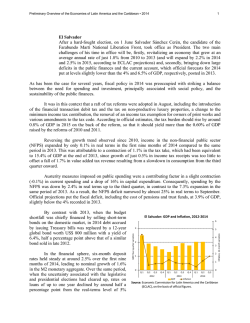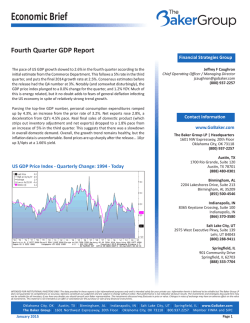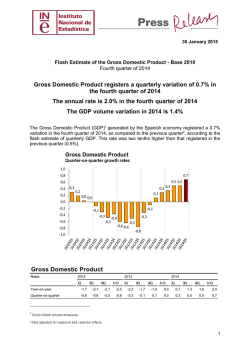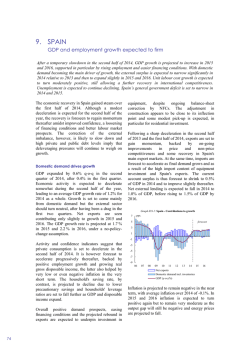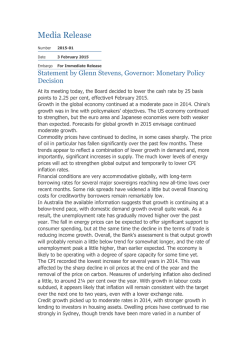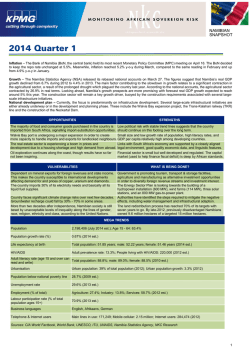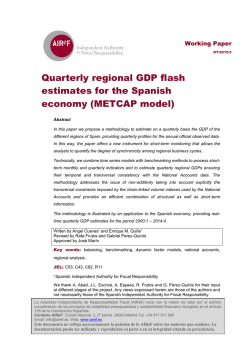
Economic Research
Economic Research Published by Raymond James & Associates Scott J. Brown, Ph.D., (727) 567-2603, [email protected] February 2 - 6, 2015 Weekly Economic Monitor _____________________________________________________________________________________ The Advance GDP Report for 4Q14 The various news agencies were quick to report that the economy “cooled” or “slowed” in the fourth quarter. However, there’s a lot more to the GDP report than the headline figure. Details confirm a lot of what we already knew. The mixed nature of the components likely led investors to focus on global weakness rather than the underlying domestic strength. As expected, the GDP report reflected a strong quarter for consumer spending (despite evidence of a “soft” December) and a relatively soft quarter for business fixed investment. Inventories rose sharply, leading to concerns that we’ll see a moderate correction in 1Q15 (that is, less production). The trade deficit was much wider than anticipated. Of course, a strong dollar and soft global growth should lead to a wider deficit. However, the data for October and November had suggested little change (hence, a sharp widening assumed for December). Domestic Final Sales (GDP less net exports and the change in inventories), a measure of underlying domestic demand, rose at a 2.8% pace, but would have been closer to 3.4% if not for a drop in defense spending. So somebody please tell me why we should focus on the headline GDP figure. Pers. Spd. Resid. Inv. Exports Ch. Invent. 6 5 Real GDP (trillion $2009) 18.0 18.0 17.5 17.5 Real GDP (BEA) Potential GDP (CBO) previous 17.0 16.5 17.0 16.5 -1.9% 16.0 16.0 15.5 15.5 -7.2% 15.0 Contributions To U.S. GDP Growth, % 7 The Fed’s plan to “normalize” monetary policy depends a lot on the perceived amount of slack in the economy. With ample slack, you’re not going to see much upward pressure on inflation. Last week, the Congressional Budget Office released revised projections, which included a downward revision to the estimates of potential GDP. The output gap now appears to be about 1.9%, vs. 7.2% at the end of the recession. Granted, these are fuzzy figures. The estimate of potential GDP depends on a lot of assumptions (such as productivity growth, a big unknown). However, taken at face value, the data suggest that the economy can grow above trend for several quarters before running into constraints that would add inflationary pressure. 15.0 7 Bus. Inv. Gov't Imports Real GDP 6 5 4 4 3 3 14.5 source: Bureau of Economic Analysis, Congressional Budget Office, Raymond James 14.0 05 06 07 08 09 10 11 12 13 14 15 16 17 Types of Economic Landings 2 1 1 0 0 -1 -1 -2 -2 potential GDP -3 -3 soft landing -4 12.1 12.2 12.3 12.4 13.1 13.2 13.3 reverse soft landing -4 13.4 14.1 14.2 14.3 hard landing 14.4 The GDP report adds to the recent underlying themes for investors. Soft global growth and a strong dollar will have a clear negative impact on the earnings of U.S. multinationals. We heard as much from several of these firms last week. However, what most people are missing is the clear strengthening of the underlying domestic economy. The labor market is improving. Consumers and small businesses are growing more optimistic. Bank credit, still relatively tight, is gradually getting easier. The housing recovery, a major disappointment so far, is exhibiting better fundamentals. While wage growth has been relatively soft, the drop in gasoline prices is providing a substantial boost to the household sector. 14.0 18 log output 2 source: Bureau of Economic Analysis 14.5 Source: Raymond James time The Fed does need to consider its end game. Its desire is to achieve a soft landing, rather than overshooting and having to endure a hard landing. Yet, there’s no sign we are going to overshoot potential GDP anytime soon. The strong dollar and soft global economy are restraints for some parts of the U.S. economy, but should be offset by areas of domestic strength. For the Fed, the bigger concern from abroad is the risk of more substantial financial market disruptions. © 2015 Raymond James & Associates, Inc., member New York Stock Exchange/SIPC. All rights reserved. All expressions of opinion reflect the judgment of the Research Department of Raymond James & Associates, Inc. (RJA) as of the date stated above and are subject to change. Information has been obtained from third-party sources we consider reliable, but we do not guarantee that the facts cited in the foregoing report are accurate or complete. Other departments of RJA may have information that is not available to the Research Department about companies mentioned in this report. RJA or its affiliates may execute transactions in the securities mentioned in this report that may not be consistent with the report's conclusions. ThisRJA trasbh clien International Headquarters: The Raymond James Financial Center | 880 Carillon Parkway | St. Petersburg, Florida 33716 | 800-248-8863 Raymond James Economic Research Treasury Yields 13-wk 26-wk 52-wk 1/02/15 1/23/15 1/30/15 0.02 0.03 0.01 0.11 0.07 0.06 0.25 0.17 0.15 Dollar 2-yr 3-yr 5-yr 10-yr 30-yr $/Euro $/BP JY/$ 0.66 0.51 0.47 1.07 0.84 0.75 1.61 1.28 1.17 2.12 1.77 1.66 2.69 2.33 2.24 1.202 1.128 1.130 1.536 1.502 1.506 120.20 117.80 117.47 Recent Economic Data and Outlook The economic data were mixed, but consistent with strong growth and very low inflation into early 2015. The Fed policy statement was, as expected, a near photocopy of the one from mid-December. Investors were battered by earnings reports and concerns about global growth. PCE Price Index, y/y % ch. 3.0 3.0 2.5 2.5 2.0 2.0 1.5 1.5 1.0 1.0 ex-food & energy 0.5 0.5 overall source: BEA 0.0 0.0 2010 2011 2012 Equities 2013 2014 2015 No surprise, Greece’s Election resulted in a shift to the left. The new leadership indicated that it has no intention of leaving the euro, but is pushing for less austerity and some debt relief, setting up a confrontation with the “Troika,” which is demanding its pound of flesh. This could drag on for a while. The Federal Open Market Committee repeated that it can “be patient in beginning to normalize the stance of monetary policy.” In deciding when to begin raising short-term interest rates, the FOMC repeated that it will take into account “a wide range of information, including measures of labor market conditions, indicators of inflation pressures and inflation expectations, and readings on financial and international developments.” The FOMC noted that the economy has been expanding at a “solid” pace (vs. a “moderate” pace in the midDecember statement). The FOMC expects inflation to “decline further in the near term,” but repeated its belief that inflation will “rise gradually toward 2% over the medium term as the labor market improves further and the transitory effects of lower energy prices and other factors dissipate.” Real GDP rose at a 2.6% annual rate in the advance estimate for 4Q14, up 2.5% y/y. Consumer spending rose at a 4.3% pace. Business fixed investment rose 1.9%. A wider trade deficit subtracted a full percentage point from GDP growth, faster inventory growth added 0.8 ppt, and a drop in defense spending subtracted 0.6 ppt. The PCE Price Index fell at a 0.5% annual rate, while core inflation slowed to 1.1% (vs. the Fed’s 2% goal). The Conference Board’s Consumer Confidence Index jumped to 102.9 in the initial estimate for January (the strongest since August 2007), vs. 93.1 in December and 79.4 a year earlier. Current job market perceptions were less depressed and CD/$ NASD SPX DJIA 1.173 4726.81 2058.20 17832.99 1.240 4757.88 2051.82 17672.60 1.270 4635.24 1995.04 17166.10 respondents were more optimistic about future job availability. Expectations of household income improved. The University of Michigan’s Consumer Sentiment Index rose to 98.1 in January (the highest since January 2004), vs. 93.6 in December. “Importantly,” according to the report, “the gains during the past six months were as large among households with incomes under $75,000 as over that amount.” The Employment Cost Index rose 0.6% over the three months ending in December, up 2.2% y/y. Wages and salaries rose 0.5% (+2.1% y/y), while benefit costs rose 0.6% (+2.6% y/y). Durable Goods Orders fell 3.4% in December, reflecting a 55.5% decline in civilian aircraft orders. However, ex-transportation orders fell 0.8% (vs. -1.3% in November and -1.2% in October). Orders for nondefense capital goods fell 0.6%, the fourth consecutive monthly decline (shipments slipped 0.2%). The Chicago Purchasing Managers Index rose to 59.4 in January, vs. 58.8 in December. Orders, production, and employment strengthened. Inventories fell sharply. Prices paid fell. New Home Sales rose 11.6% (±16.5%), to a 481,000 seasonally adjusted annual rate (+8.8% ±17.9% y/y). Existing Home Sales rose 2.4% in December, to a 5.04 million seasonally adjusted annual rate (+3.5% y/y). Results were mixed across regions. Homes for sale fell 11.1% (-0.5% y/y). The Pending Home Sales Index fell 3.7% in December (+6.1% y/y). The National Association of Realtors cited low inventories of homes for sale, but remained optimistic. The Congressional Budget Office expects a deficit of 2.6% of GDP in FY15 (but it should start rising again after FY17). Economic Outlook (1Q15): Real GDP growth of 2.5-3.0%. Employment: The unemployment insurance claims data suggest no appreciable increase in layoffs (beyond the usual seasonal pattern) in early 2015. Small firms are hiring. Consumers: Strong job growth is a plus and lower gasoline prices will boost consumer purchasing power in 2015. Confidence is rising, but we still need to see a pickup in wages. Manufacturing: Mixed. A stronger dollar and weakness in the global economy are expected to restrain exports, but domestic demand should strengthen in the months ahead. Housing/Construction: Supply constraints have eased and affordability has improved. Look for a better balance in 2015 (less speculative buying, better consumer fundamentals). Prices: The PCE Price Index remains well below the Fed’s 2% goal – and the core rate is moving in the wrong direction. Pipeline pressures are mild. Wage pressures are limited. Inflation expectations remain well-anchored, but may decline. Interest Rates: With low inflation and a still-high elevated level of slack in the economy, the Fed can be patient in deciding when to begin raising short-term interest rates. Global financial conditions are also a consideration (along with the outlooks for inflation and the job market). © 2015 Raymond James & Associates, Inc., member New York Stock Exchange/SIPC. All rights reserved. International Headquarters: The Raymond James Financial Center | 880 Carillon Parkway | St. Petersburg, Florida 33716 | 800-248-8863 2 Raymond James Economic Research This Week: Sunday 2/01 Monday 2/02 Tuesday 2/03 Wednesday 2/04 Thursday 2/05 Friday 2/06 forecast last last –1 comments +0.3% -0.2% +0.0% NF +1.0% 54.4 +0.4% +0.6% +0.0% 53.9 -0.3% 55.1 +0.3% +0.3% +0.2% 54.8 +1.2% 57.6 soft wage strength pulled into November weak retail sales results (but quirky) the core CPI rose 0.003% 53.7 in the flash estimate minor implications for GDP revision likely to be mixed -2.3% 16.9 13.6 +210 57.0 -0.7% 16.8 13.5 +241 56.5 -0.7% 17.1 13.8 +227 58.8 lower oil, but a soft trend otherwise results usually depend on final weekend but likely to remain relatively strong moderately strong some pickup likely 295 -0.1% +2.3% -44.4 -63.7 +195 +190 5.6% 62.8% 34.6 +0.2% 265 +2.3% -1.0% -39.0 -58.3 252 240 5.6% 62.7% 34.6 -0.2% 308 +2.9% -3.7% -42.2 -61.6 353 345 5.8% 62.9% 34.6 +0.2% no change perhaps a mild weather impact seen about flat uneven in recent quarters assumed a lot wider in the GDP est. imports up, exports down annual benchmark revisions due a more moderate pace seen in 1Q15 should be little changed trending flat, but better for ages 25-54 seen steady mild wage pressures Jan Dec NF NF NF 100.4 3.6% 1.9% Jan NF -10.3 2/07 Jan 292 +0.3% +0.2% +0.5% +0.1% 295 -0.9% -1.0% -0.2% +0.2% NF NF 100.0 -2.5% -0.1% 98.1 Super Bowl XLIX NE Patriots vs. Seattle Seahawks 8:30 Personal Income Personal Spending PCE Price Index ex-f&e 9:45 Markit US Manf PMI (final) 10:00 Construction Spending 10:00 ISM Manf. Index Dec 10:00 Factory Orders tbd Motor Vehicle Sales, mln domestically built 8:15 ADP Payroll Estimate, th. 10:00 ISM Non-Manf. Index Dec Jan 7:00 BOE Policy Decision 8:30 Jobless Claims, th. 8:30 Productivity (prelim.) Unit labor Costs 8:30 Trade Balance, $bln goods only 8:30 Nonfarm Payrolls, th. private-sector Unemployment Rate Employment/Population Avg. Weekly Hours Avg. Hourly Earnings Jan Jan Jan Jan 1/31 4Q14 Dec Jan Next Week: Monday 2/09 no significant data Tuesday 2/10 Wednesday 2/11 7:30 Small Business Optimism 10:00 JOLTS: hiring rate JOLTS: quit rate 1:00 Treasury Note Auction 1:00 Treasury Note Auction 2:00 Treasury Budget, $bln Thursday Friday 2/12 2/13 8:30 Jobless Claims, th. 8:30 Retail Sales ex-autos ex-autos, bld mat, gasoline 10:00 Business Inventories 1:00 Treasury Bond Auction 8:30 Import Prices ex-food & fuel 9:55 UM Consumer Sentiment Dec Jan m-Feb This Week… A busy week for economic data, but we may not get a clear picture due to potential distortions from seasonal adjustment. For example, we can expect to lose more than 2.8 million jobs each January. Are we really going to worry about the nearest 20,000 or so in the adjusted figure? Yes, we are. Even with the onslaught of data, earnings reports and overseas developments are still likely to influence the stock market. 98.1 trending higher 3.7% a gradual trend higher 1.9% but still below normal 3-year notes 10-year notes +2.9 seen moderate 295 +0.4% +0.1% +0.5% +0.2% still subject to some seasonal noise moderate (watch for revisions) lower gasoline prices expected to rebound reduced by lower oil prices 30-year bonds -1.8% falling oil prices -0.2% but disinflationary pressure otherwise 93.6 trending higher consumer spending. Lower gasoline prices will drive inflation lower, but the core rate is also edging down. 11.2 Real Consumer Spending, trillion 2009 dollars, annual rate 11.1 11.0 11.2 11.1 quarter 11.0 month Monday 10.9 10.9 Personal Income and Spending (December) – Quarterly figures 10.8 10.8 10.7 10.7 10.6 10.6 were included in the GDP report. The monthly figures would normally give us a good idea of the momentum heading toward 1Q15. However, other data reports suggest that some of December’s seasonal strength was likely pulled forward into November (it was a strong quarter). The 4Q14 GDP data suggest a modest gain in income in December and a decline in Source: Bureau of Economic Analysis 10.5 10.5 2013 2014 © 2015 Raymond James & Associates, Inc., member New York Stock Exchange/SIPC. All rights reserved. International Headquarters: The Raymond James Financial Center | 880 Carillon Parkway | St. Petersburg, Florida 33716 | 800-248-8863 2015 3 Raymond James Economic Research Construction Spending (December) – Not market-moving, these figures could have some minor implications for GDP revisions. ISM Manufacturing Index (January) – Softer global growth and a stronger dollar should be having a negative impact on exporters. Increasing strength in the domestic economy should help offset that somewhat. Results are likely to be mixed across industries. Seasonal adjustment may exaggerate weather effects. ISM Manufacturing Index and Components 60 10 58 8 56 6 54 4 52 2 50 0 48 -2 46 -4 44 42 40 38 36 34 source: Institute for Supply Management 06 07 08 09 10 11 12 13 14 142 source: BLS 141 140 140 139 139 138 138 137 137 -8 136 136 -10 135 135 -12 -14 32 05 Nonfarm Payrolls (million, not seas. adj.) 142 141 -6 Inventories Supplier Deliveries Employment Production New Orders ISM Manf. Index weight on the adjusted payroll figure (but the markets likely will). This release will include annual benchmark revisions to the payroll data (based on actual payroll tax receipts), but that shouldn’t matter much. In September, the BLS estimated that this revision would lift the March 2014 payroll figure by just 7,000 (less than 0.05%) – that’s tiny. The unemployment rate should hold roughly steady, but the trend is lower. While payroll growth has been strong, we haven’t seen much of a pickup in the employment/population ratio. 134 -16 133 -18 132 15 134 2014-15 133 2013-14 2012-13 132 2011-12 131 131 Tuesday Factory Orders (December) – Orders for durable goods (which account for most of the volatility) were reported to have fallen by 3.4% (following a 2.1% decline in November). Orders for nondurables should reflect the drop in oil prices. Jul Aug Sep Oct Nov Dec Jan Feb Mar Apr May Jun Employment / Population, % 81 64 Aged 25-54 (left) Total (right) 80 63 79 62 78 61 Wednesday 77 60 ADP Payroll Estimate (January) – Everyone knows that the ADP 76 59 figure is not a good predictor of the monthly change in the BLS data. Nevertheless, the financial markets may react to a surprise (and there’s a good chance of that). 75 Unit Auto Sales (January) – Replacement needs and relatively easy bank credit should continue to support auto sales in 2015. Strong job growth and lower gasoline prices will also help. ISM Non-Manufacturing Index (January) – These figures should remain consistent with moderately strong growth in the overall economy. Watch new orders and employment. Thursday Jobless Claims (week ending January 31) – The figures are still subject to seasonal noise, but the underlying trend suggests no appreciable increase in early 2015 (either due to layoffs in the energy sector or due to an unwinding of seasonal strength). Trade Balance (December) – In the advance GDP estimate, the 58 source: Bureau of Labor Statistics 74 57 07 08 09 10 11 12 13 14 15 Next Week … The economic calendar thins out. January is not a critical month for most retailers, but the financial markets are expected to pay attention to the sales data, which should rebound from a “soft” December (the trend was strong in 4Q14). Coming Events and Data Releases February 12 Retail Sales (January) February 16 Presidents Day (markets closed) March 18 FOMC Policy Decision, Yellen press conference Friday March 6 Employment Report (February) Employment Report (January) – We normally lose over 2.8 April 29 FOMC Policy Decision (no press conference) million jobs each January, largely reflecting the end of the holiday shopping period. Hence, one should not put much June 17 FOMC Policy Decision, Yellen press conference Bureau of Economic analysis assumed a sharp widening of the trade deficit in December, reflecting a drop in exports and a pickup in imports. The deficit should widen further in 2015. © 2015 Raymond James & Associates, Inc., member New York Stock Exchange/SIPC. All rights reserved. International Headquarters: The Raymond James Financial Center | 880 Carillon Parkway | St. Petersburg, Florida 33716 | 800-248-8863 4
© Copyright 2025
